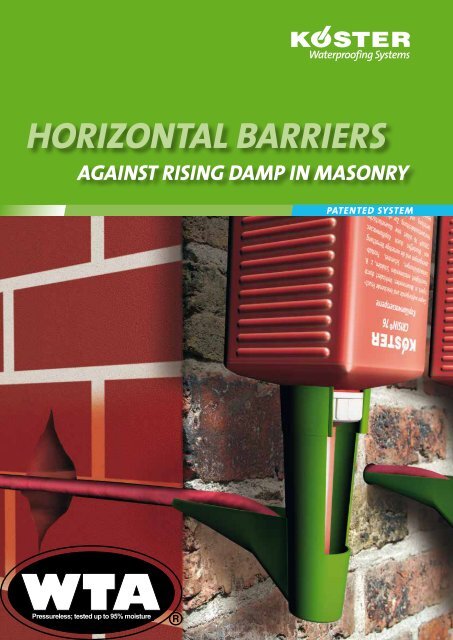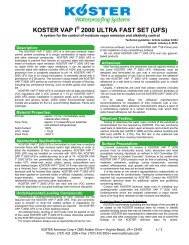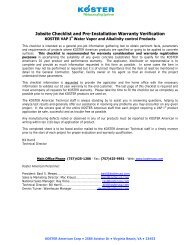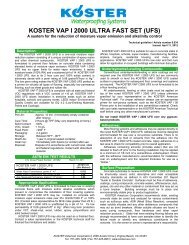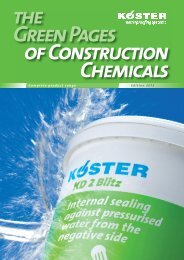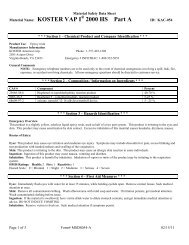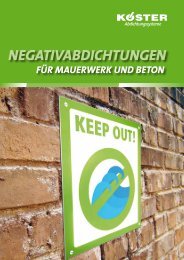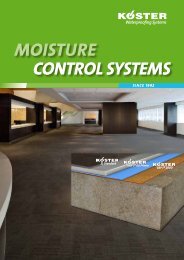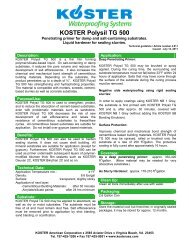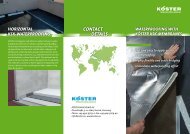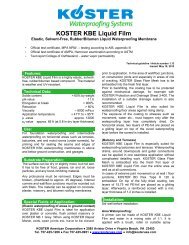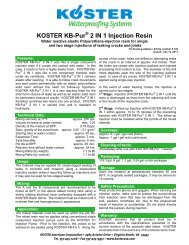III Horizontal Barriers against rising damp in mansonry - Koster
III Horizontal Barriers against rising damp in mansonry - Koster
III Horizontal Barriers against rising damp in mansonry - Koster
You also want an ePaper? Increase the reach of your titles
YUMPU automatically turns print PDFs into web optimized ePapers that Google loves.
HORIZONTAL BARRIERSAGAINST RISING DAMP IN MASONRYPATENTED SYSTEMPressureless; Druck<strong>in</strong>jektion; tested up DFG to 95% ≤ moisture 95 %R
Why is <strong>ris<strong>in</strong>g</strong> <strong>damp</strong> a concern for build<strong>in</strong>g owners?Ris<strong>in</strong>g <strong>damp</strong> is among the most frequentlyencountered causes of damage to masonrywalls. The results are usually clearly identifiablethrough spall<strong>in</strong>g of plaster, damaged jo<strong>in</strong>ts andbricks but also through salt efflorescence andalgae growth.Change of colour, reduction of the thermal <strong>in</strong>sulation.Damaged plaster / renderDestruction of render and mortar jo<strong>in</strong>tsOver time <strong>ris<strong>in</strong>g</strong> <strong>damp</strong> <strong>in</strong> comb<strong>in</strong>ation withsalt contam<strong>in</strong>ation and / or frost can destroymasonry structurally. Tak<strong>in</strong>g <strong>in</strong>to account theDevelopment of mould and damage to the fabric of thestructuredecrease of the rema<strong>in</strong><strong>in</strong>g lifespans of suchbuild<strong>in</strong>gs, <strong>ris<strong>in</strong>g</strong> <strong>damp</strong> causes high f<strong>in</strong>ancialdamage every year.How does <strong>ris<strong>in</strong>g</strong> <strong>damp</strong> damage masonry?In masonry that is affected by <strong>ris<strong>in</strong>g</strong> <strong>damp</strong>,moisture is cont<strong>in</strong>uously transported upwardthrough the capillaries. The water evaporateson the surface and more moisture follows. Thisprocess will usually lead to an <strong>in</strong>crease <strong>in</strong> theconcentration of salts on the surface. Mostevaporation takes place <strong>in</strong> the area betweenthe dry (top) and the <strong>damp</strong> part of the wall(bottom). In these areas, there are often the firstsigns of damage.
Destruction of render and mortar jo<strong>in</strong>tsSalt crystallizationRis<strong>in</strong>g <strong>damp</strong>Where does the water come from?OutsideRa<strong>in</strong> waterInsideCondensationTop ground surfaceSplash waterGround moistureCapillary condensationSeepageGround waterThere are many sources from which water canget to a wall such as ra<strong>in</strong> water, ground waterand condensate (see graphic). Also leak<strong>in</strong>g guttersor dra<strong>in</strong>age pipes can be sources of water. Ifthe water which is enter<strong>in</strong>g a wall is constantlyreplenished then a cont<strong>in</strong>uous transport ofwater through the capillaries of the build<strong>in</strong>gmaterial will take place. The water rises upwards<strong>aga<strong>in</strong>st</strong> gravity due to a mechanism calledcapillary action.<strong>Horizontal</strong> <strong>Barriers</strong> 2 | 3
Is it <strong>ris<strong>in</strong>g</strong> <strong>damp</strong>?A wall with damage apparently attributableto <strong>ris<strong>in</strong>g</strong> <strong>damp</strong> should always be analyzed bya specialist before any renovation measuresare undertaken. Determ<strong>in</strong><strong>in</strong>g the cause of thedamage is always important. Information suchas the type of damage, the characteristics ofthe build<strong>in</strong>g, as well as the salt and moisturecontents of the build<strong>in</strong>g materials all have to betaken <strong>in</strong>to consideration when determ<strong>in</strong><strong>in</strong>g howto repair the damage and remove its cause.The source of damage may not always be <strong>ris<strong>in</strong>g</strong><strong>damp</strong>. Other possibilites are: splash water abovea function<strong>in</strong>g horizontal barrier, hygroscopicaction or just leak<strong>in</strong>g pipe <strong>in</strong>stallations. If it is<strong>ris<strong>in</strong>g</strong> <strong>damp</strong>, the restoration has to take <strong>in</strong>toaccount the salt and moisture content of thebuild<strong>in</strong>g material. Therefore, a salt and moistureanalysis is recommended.Why does moisture rise <strong>in</strong> masonry?Interfacial tension of liquids (adhesion)Surface tension of water (cohesion)Ris<strong>in</strong>g <strong>damp</strong> is an effect created by the surface tension of a liquid (cohesion) and the <strong>in</strong>terfacialtension (adhesion) between the liquid and the solid surface. Generally a liquid has the tendency tospread when it comes <strong>in</strong> contact with a surface. On the other hand liquids like water have a surfacetension. These two forces together, lead to the effect that water rises <strong>in</strong> a narrow pipe (see graphic).Example for <strong>ris<strong>in</strong>g</strong> <strong>damp</strong>Build<strong>in</strong>g materials like bricks absorb water <strong>in</strong> asimilar way to a sponge (see photo). This occursbecause masonry as well as concrete conta<strong>in</strong>small pores. Depend<strong>in</strong>g on the diameter ofthe pores, they can tranport water upwards<strong>aga<strong>in</strong>st</strong> gravity (<strong>ris<strong>in</strong>g</strong> <strong>damp</strong>). Pores with aradius between 10 -7 m and 10 -4 m show the mostdist<strong>in</strong>ctive water transport and are referred toas capillaries. Between 20 % and 50 % of thepores <strong>in</strong> the build<strong>in</strong>g materials concrete, brickand mortar fall <strong>in</strong>to that category. Pores withRis<strong>in</strong>g of liquids <strong>in</strong> capillariesa radius of below 10 -7 m are called micro poresand are too small for capillary water transport,where as pores with a radius of above 10 -4 m aretoo large.The smaller the diameter of the capillary, thelarger the capillary pressure and the higher thecapillary elevation. A capillary with a diameterof 1 µm (10 -6 m) can theoretically create a suctionpressure of 1.5 bar which corresponds to a capillaryelevation of water of approximately 15 m.
What have salts got to do with <strong>ris<strong>in</strong>g</strong> <strong>damp</strong>?Usually, the water which is transported <strong>in</strong>to andthrough a wall conta<strong>in</strong>s salts. These salts canhave different sources:• Salts are present <strong>in</strong> the ground. They can bedissolved <strong>in</strong> ground water or ground moistureand can then be transported with the groundwater <strong>in</strong>to the wall.• Salts are present <strong>in</strong> the brick itself. Thesesalts can be dissolved by the <strong>ris<strong>in</strong>g</strong> <strong>damp</strong> <strong>in</strong>the masonry.• Salts have other sources such as deic<strong>in</strong>g salt,fertilizer or feces which are transported by ra<strong>in</strong>water, splash water or ground water <strong>in</strong>to thewall.When the salt conta<strong>in</strong><strong>in</strong>g water evaporates <strong>in</strong>the surface area of the wall, the salt rema<strong>in</strong>s <strong>in</strong>the wall or on its surface, lead<strong>in</strong>g to an <strong>in</strong>creaseof the salt concentration. The salt crystallizeson the surface or <strong>in</strong> the pores of the build<strong>in</strong>gmaterial. This process is characterized bydirected growth, an <strong>in</strong>crease <strong>in</strong> volume and highstrength of the crystals. When salt crystals form<strong>in</strong> the pores of a build<strong>in</strong>g material over a longerperiod of time, a high crystallization pressurebuilds up. This eventually leads to a destructionof the pore. Once this process has proceeded farenough, the surface of the construction materialbecomes brittle and starts to fall off.Ris<strong>in</strong>g <strong>damp</strong>Damaged surfaceSalt crystals on the surfaceDestructive crystallization processFrost has a very similar effect. The ice crystalsthat form when a specific amount of liquidwater freezes have a much larger volume thanthe same amount of liquid water. If waterfreezes <strong>in</strong> the pores, the expand<strong>in</strong>g ice crystalsbuild up a high pressure and can lead to thedestruction of the build<strong>in</strong>g material.<strong>Horizontal</strong> <strong>Barriers</strong> 4 | 5
How can <strong>ris<strong>in</strong>g</strong> <strong>damp</strong> be stopped?There are two fundamental ways to stop<strong>ris<strong>in</strong>g</strong> <strong>damp</strong>: Block<strong>in</strong>g capillary active pores orhydrophob<strong>in</strong>g their surfaces. Hydrophob<strong>in</strong>g thesurface of a pore means to modify the surface sothat it becomes water repellent (hydrophobic).Thus, the capillary action of that pore is stopped.Block<strong>in</strong>g a pore means to partially or totally fillthe pore <strong>in</strong> order to stop the transport of water.It is crucial to br<strong>in</strong>g enough material <strong>in</strong>to thepore so that the diameter of the pore is narrowedfar enough and no more capillary actioncan take place.Hydrophob<strong>in</strong>g : Mak<strong>in</strong>g the build<strong>in</strong>g material water repellentKÖSTER Cris<strong>in</strong>® 76 stops <strong>ris<strong>in</strong>g</strong> <strong>damp</strong> withthree effects: It l<strong>in</strong>es the capillary with a waterrepellent film. Secondly it narrows the pore somuch that capillary action cannot take placeany more. F<strong>in</strong>ally, KÖSTER Cris<strong>in</strong>® 76 can cure toform a membrane over the complete diameterof the capillary.These effects together ensure that KÖSTERCris<strong>in</strong>® 76 works every time, irrespective of porestructure, salt or moisture content. The firstbuild<strong>in</strong>gs were treated more than 25 years agoNarrow<strong>in</strong>g/block<strong>in</strong>g the capillary, form<strong>in</strong>g an elastic film<strong>in</strong> the capillaryand those horizontal barriers are still <strong>in</strong>tactand work<strong>in</strong>g. KÖSTER Cris<strong>in</strong>® 76 has a very lowviscosity and is not water soluble. It penetratesdeeply <strong>in</strong>to even the smallest capillaries <strong>in</strong> build<strong>in</strong>gmaterials where it stops capillary actionpermanently.Due to the hydrophobic effect of KÖSTERCris<strong>in</strong>® 76, the dry<strong>in</strong>g process <strong>in</strong> the wall beg<strong>in</strong>simmediately, creat<strong>in</strong>g an active horizontal barrieras soon as the material has been <strong>in</strong>stalled.Advantages of KÖSTER Cris<strong>in</strong>® 76• suitable even <strong>in</strong> cases of high moisture contentsuntil 95 % (tested accord<strong>in</strong>g to WTA standards)• suitable even <strong>in</strong> cases of high salt contents• suitable for most types of salts(sulfates, nitrates, chlorides)• the treated substrate does not have to be alkal<strong>in</strong>efor the material to react• no prior or subsequent dry<strong>in</strong>g of the wallnecessary, even <strong>in</strong> case of high moisture contents• application possible even at temperaturesbelow +5°C• can not be diluted with water / is not watersoluble• resistant <strong>aga<strong>in</strong>st</strong> most ord<strong>in</strong>ary aggressivesubstances that are encountered <strong>in</strong> masonrysuch as acids, alkalis and salts• fast reaction, immediately effective• not bio-degradable• not frost sensitive• does not cause or promote corrosion of steelre<strong>in</strong>forcements• density (0,76 g/cm 3 ); penetrates deeply even<strong>in</strong>to the smallest capillaries of the constructionmaterial• the cured material and thus the horizontalbarrier is elastic• can be applied to perforated brick and crackedor hollow masonry without hav<strong>in</strong>g to fill thevoids beforehand• no subsequent <strong>in</strong>jection necessary, one time<strong>in</strong>stallation, guaranteed success• patented system• easy <strong>in</strong>stallation, horizontal drill<strong>in</strong>g• proven to be effective for more than 25 years• 10 years warranty*KÖSTER Cris<strong>in</strong>® 76 ist chemically neutral and does not cause efflorescence. It is furthermore resistant <strong>aga<strong>in</strong>st</strong>most ord<strong>in</strong>ary aggressive substances that are encountered <strong>in</strong> masonry like diluted acids and alkalis.* Under the condition that the material is applied by a certified applicator.
The patented KÖSTER Suction Angle System isthe result of decades of experience <strong>in</strong> combat<strong>in</strong>g<strong>ris<strong>in</strong>g</strong> <strong>damp</strong>, <strong>in</strong>volv<strong>in</strong>g extensive research anddevelopment by KÖSTER BAUCHEMIE AG. Thehorizontal barrier is <strong>in</strong>stalled solely throughutilization of capillary action which is itselfthe cause for <strong>ris<strong>in</strong>g</strong> <strong>damp</strong>. Thus, <strong>ris<strong>in</strong>g</strong> <strong>damp</strong> isstopped with the aid of its cause.The system consists of the KÖSTER Cris<strong>in</strong>® 76cartridge, the KÖSTER Capillary Rod and theKÖSTER Suction Angle.KÖSTER Cris<strong>in</strong>® 76 KÖSTER Capillary Rods KÖSTER Suction AngleThe KÖSTER Capillary Rod acts like a wick, oneend is <strong>in</strong>serted <strong>in</strong>to the wall and the other end<strong>in</strong>to the KÖSTER Suction Angle. From there, theit draws the <strong>in</strong>jection liquid <strong>in</strong>to the wall. TheKÖSTER Capillary Rod is available <strong>in</strong> a length of45 or 90 cm.This is a crucial advantage not only when<strong>in</strong>stall<strong>in</strong>g horizontal barriers <strong>in</strong>to hollow bricks,vertically perforated bricks or old and crackedmasonry, but also for all other conditions. Themethod allows easy control of the distributionof the <strong>in</strong>jection material <strong>in</strong> the wall. It also givessecurity <strong>in</strong> the calculation of costs for the <strong>in</strong>stallationof a horizontal barrier s<strong>in</strong>ce the amountof material needed can be easily determ<strong>in</strong>ed.<strong>Horizontal</strong> <strong>Barriers</strong> 6 | 7
How to apply KÖSTER Cris<strong>in</strong>® 76• Remove the plaster and any loose materialscompletely from the wall.• Drill the boreholes at the required distance(see table). The length of the borehole is thethickness of the wall m<strong>in</strong>us 5 cm. Cleanthe boreholes, preferably with pressurised air<strong>in</strong> order to remove the dust.• After that, the KÖSTER Capillary Rod is cutto the required length (depth of the borehole+ 7 cm) and <strong>in</strong>serted <strong>in</strong>to the borehole.• Then the KÖSTER Suction Angle is <strong>in</strong>stalledand the supply chamber of the KÖSTER SuctionAngle is filled with water. This has the effectthat the KÖSTER Capillary Rod swells a littlebit and thereby makes good contact with thewall of the borehole. Then, the cartridge filledwith KÖSTER Cris<strong>in</strong>® 76 is set <strong>in</strong>to the KÖSTERSuction Angle. KÖSTER Cris<strong>in</strong>® 76 flows <strong>in</strong>to thesupply chamber of the KÖSTER Suction Anglewhere the liquid is absorbed by the KÖSTERCapillary Rod. The <strong>in</strong>jection liquid is transportedthrough the KÖSTER Capillary Rod. It is onlyreleased <strong>in</strong>to the wall where the KÖSTERCapillary Rod has contact with the wall of theborehole. In those places where the KÖSTERCapillary Rod does not have contact with thewall of the borehole – like cracks and voids <strong>in</strong>the masonry - no <strong>in</strong>jection liquid is releasedand thus no <strong>in</strong>jection liquid is lost <strong>in</strong>to cracks orvoids.KÖSTER Cris<strong>in</strong>® 76KÖSTER Suction AngleKÖSTER Capillary Rod5 cm• Once the cartridge is empty, the cartridge andthe suction angle can be removed. Both canbe reused.• After the <strong>in</strong>stallation of KÖSTER Cris<strong>in</strong>® 76the boreholes are closed us<strong>in</strong>g e.g. KÖSTERKB-Fix 5.• As an ideal comb<strong>in</strong>ation KÖSTER RestorationPlaster is applied afterwards.The consumption depends on the thickness of the wall. With the follow<strong>in</strong>g table the consumptioncan easily be calculated.Thickness of wall ø of bore holes boreholes per Distance between drill<strong>in</strong>g Cartridge per Cartridge per meter Maximum consumption<strong>in</strong>cl. Plaster meter holes from center to borehole of capillary rodcenter (horizontal) (45 cm) (90 cm)[mm] [cm] [piece] [piece] [maximum pieces per m]up to 30,0 cmup to 40,0 cmup to 50,0 cmup to 60,0 cmup to 70,0 cmup to 80,0 cmif necessary proportionally less than one cartridge can be applied14 8 12,5 1 8 8 414 10 10 1 10 12 614 11 9 1 11 16 814 13 7,5 1 13 21 1114 15 6,5 1 15 28 14
InstallationThe follow<strong>in</strong>g pictures show the <strong>in</strong>stallation of a new horizontal barrier with KÖSTER Cris<strong>in</strong>® 76 <strong>in</strong> ahistoric build<strong>in</strong>g.1.2.The masonry is from 1750, the exist<strong>in</strong>g plaster is damaged.The salt and moisture contents are high.Boreholes are drilled <strong>in</strong>to the <strong>in</strong>terior walls at a distance of 10cm from each other (wall thickness 45 cm) up to a depth of40 cm.3.4.The boreholes are cleaned from dust by blow<strong>in</strong>g the dust outof the borehole with pressurised air.KÖSTER Capillary Rods are <strong>in</strong>stalled so that they protrude7 cm from the borehole.5.6.The KÖSTER Suction Angles are <strong>in</strong>stalled so that the KÖSTERCapillary Rods reach <strong>in</strong>to the supply chamber of the KÖSTERSuction Angles.The supply chambers of the KÖSTER Suction Angles are filledwith water <strong>in</strong> order to pre-water the KÖSTER Capillary Rods.7. 8.The KÖSTER Cris<strong>in</strong>® 76 cartridges are <strong>in</strong>stalled.The pressureless <strong>in</strong>jection of KÖSTER Cris<strong>in</strong>® 76 <strong>in</strong>to themasonry starts immediately after the <strong>in</strong>stallation of thecartridges.<strong>Horizontal</strong> <strong>Barriers</strong> 8 | 9
How fast does KÖSTER Cris<strong>in</strong>® 76 become active?Generally, the KÖSTER Cris<strong>in</strong>® 76 cartridgesempty with<strong>in</strong> 48 hours after they have been<strong>in</strong>stalled. Now the horizontal barrier has beensuccessfully <strong>in</strong>stalled. Due to the hydrophobiccharacteristics of KÖSTER Cris<strong>in</strong>® 76, the reductionof <strong>ris<strong>in</strong>g</strong> <strong>damp</strong> starts immediatelyafter the <strong>in</strong>stallation. The horizontalbarrier becomes fully effective with<strong>in</strong>the cur<strong>in</strong>g time of the res<strong>in</strong> which cantake up to 10 days. Dur<strong>in</strong>g thisperiod, the masonry alreadybeg<strong>in</strong>s to dry. The dry<strong>in</strong>gtime depends ma<strong>in</strong>ly onthe moisture contentand the thickness ofthe walls. The moisturecontent can bedeterm<strong>in</strong>ed by tak<strong>in</strong>gcore samples whichare then weighed anddried accord<strong>in</strong>g to thekiln-dry method.Often masonry burdened by <strong>ris<strong>in</strong>g</strong> <strong>damp</strong> conta<strong>in</strong>shigh salt concentrations. Therefore, dur<strong>in</strong>gthe first weeks of dry<strong>in</strong>g after the <strong>in</strong>stallationof a horizontal barrier, salts may diffuse to thesurface caus<strong>in</strong>g salt efflorescence. This is partof the dry<strong>in</strong>g process. The efflorescencecan be removed mechanically (do notuse water). It is recommended to applyKÖSTER Restoration Plaster after theapplication of KÖSTER Cris<strong>in</strong>® 76thereby prevent<strong>in</strong>g any effectsof salt efflorescence.The perfect system: KÖSTER Cris<strong>in</strong>® 76 and KÖSTERRestoration PlasterKÖSTER restoration plasters are especiallydesigned for the restoration of masonry withhigh salt and moisture contents. When <strong>ris<strong>in</strong>g</strong><strong>damp</strong> is stopped with KÖSTER Cris<strong>in</strong>® 76, KÖSTERrestoration plasters help to dry out the wall andit absorbs rema<strong>in</strong><strong>in</strong>g salts. KÖSTER restorationplasters withstand moist conditions s<strong>in</strong>ce theydo not conta<strong>in</strong> lime or gypsum. They are opento water vapour diffusion and help to create ahealthy and comfortable room climate. Theyare also not effected by high salt contents andprevent salts from diffus<strong>in</strong>g to the surface. ApplyKÖSTER Polysil® TG 500 as a primer <strong>in</strong> order tostrengthen the substrate and reduce the mobilityof the salt molecules. KÖSTER restorationplasters are available <strong>in</strong> grey or white. In historicbuild<strong>in</strong>gs they can be used as a decorativeplaster even without pa<strong>in</strong>t<strong>in</strong>g. They are suitablefor <strong>in</strong>terior and exterior use.The <strong>in</strong>terior walls of these build<strong>in</strong>gs were restored with KÖSTER Restoration Plaster 2 White.
KÖSTER Restoration PlasterKÖSTER Polysil® TG 500Salts crystallize <strong>in</strong> the pores of KÖSTER RestorationPlaster and can not cause damage thereby.InstallationRemove old plaster. Fill breakoutsand holes with KÖSTER RepairMortar. Spray KÖSTER Polysil ® TG500 onto the surface to blocksalts and strengthen thesubstrate.At the earliest after 30 m<strong>in</strong>utesapply a plaster key to ensureoptimal bond<strong>in</strong>g of KÖSTERRestoration Plaster.Apply KÖSTER RestorationPlaster onto the cured plasterkey by trowel or use theKÖSTER Variojet.After approximately 60m<strong>in</strong>utes, smooth thesurface.<strong>Horizontal</strong> <strong>Barriers</strong> 10 | 11
How is a horizontal barrier <strong>in</strong>stalled <strong>in</strong> comb<strong>in</strong>ationwith negative side or positive side waterproof<strong>in</strong>g?Subsequent waterproof<strong>in</strong>g normally <strong>in</strong>cludesvarious measures such as the <strong>in</strong>stallation ofarea waterproof<strong>in</strong>g for walls and floors and the<strong>in</strong>stallation of a horizontal barrier with<strong>in</strong> themasonry. The <strong>in</strong>stallation of a horizontal barrieris a key element <strong>in</strong> any restoration waterproof<strong>in</strong>gproject.KÖSTER NB 1 GreyWaterproof<strong>in</strong>g layer withKÖSTER Deuxan®Protection layer withKÖSTER Protectionand Dra<strong>in</strong>age Sheet 3-400Fillet with KÖSTERRepair MortarBreak EdgesKÖSTER Polysil® TG 500KÖSTER RestorationPlaster 2 White<strong>Horizontal</strong> barrier withKÖSTER Cris<strong>in</strong>® 76Waterproof<strong>in</strong>g layer withKÖSTER Deuxan® 2CGlid<strong>in</strong>g layerProtection layerKÖSTER Polysil® TG 500Protection layer<strong>Horizontal</strong> barrier withKÖSTER Cris<strong>in</strong>® 76Waterproof<strong>in</strong>g layer withKÖSTER NB 1 Grey and / orKÖSTER KD SystemKÖSTER RestorationPlaster 2 WhiteWaterproof<strong>in</strong>g layerwith KÖSTER NB 1 GreyGlid<strong>in</strong>g layerDra<strong>in</strong>ageThe left side of the draw<strong>in</strong>g shows the solutionwith positive side waterproof<strong>in</strong>g. It requires thatthe ground on the outside of the basement wallis excavated and the waterproof<strong>in</strong>g is <strong>in</strong>stalledon the outside of the wall. The advantage isthat the wall is dry after the waterproof<strong>in</strong>g hasbeen <strong>in</strong>stalled. This solution can be implementedby us<strong>in</strong>g the KÖSTER Deuxan® system. In thiscase, the horizontal barrier with KÖSTER Cris<strong>in</strong>®76 is placed as low as possible. The purpose ofthe horizontal barrier here is to ensure thatmoisture can not rise from the foundation <strong>in</strong>tothe masonry wall.The right side shows negative side waterproof<strong>in</strong>g.It is usually the cheaper and faster possibilitybecause it is carried out from the <strong>in</strong>side.The KÖSTER KD-System together with KÖSTERNB 1 Grey is the perfect choice for such a solution.The horizontal barrier with KÖSTER Cris<strong>in</strong>®76 is placed 30 cm above ground level. Thewaterproof<strong>in</strong>g layer on the <strong>in</strong>side of the wallensures that no water can penetrate <strong>in</strong>to thebasement. The purpose of the horizontal barrier<strong>in</strong> this case is to ensure that moisture can notrise <strong>in</strong>to the constuction members above.
Pressurised or pressureless <strong>in</strong>jection?Generally, horizontal barriers can be <strong>in</strong>stalledwith high pressure <strong>in</strong>jection or with pressureless<strong>in</strong>jection. High pressure <strong>in</strong>jection requiresthe use of <strong>in</strong>jection ports or so called “packers”,which are fixed <strong>in</strong> the boreholes. With ahigh-pressure <strong>in</strong>jection pump, a suited materialis then <strong>in</strong>jected <strong>in</strong>to the wall through thesepackers. With this method the <strong>in</strong>jection materialcan be applied very fast. This advantage is offsetthough, if the masonry conta<strong>in</strong>s voids becausethese voids would be filled with the <strong>in</strong>jectedmaterial dur<strong>in</strong>g high-pressure <strong>in</strong>jection and thusbe lost. To avoid wast<strong>in</strong>g <strong>in</strong>jection material <strong>in</strong>voids and cracks, the boreholes are <strong>in</strong>jected witha borehole suspension <strong>in</strong> a preced<strong>in</strong>g work step<strong>in</strong> order to fill voids and cracks <strong>in</strong> the masonry.The boreholes are then drilled open aga<strong>in</strong> andnow the material for the horizontal barriers canbe <strong>in</strong>jected. Additionally, even with very highpressure, the f<strong>in</strong>est capillaries cannot be filled.Pressurised <strong>in</strong>jectionPressureless <strong>in</strong>jectionThe KÖSTER pressureless <strong>in</strong>jection method withKÖSTER Cris<strong>in</strong>® 76 <strong>in</strong> contrast utilizes the wall’scapillary action. The remedy is <strong>in</strong>jected us<strong>in</strong>g thesource of the problem. Advantages of <strong>in</strong>jectionwithout pressure are:• The <strong>in</strong>jected liquid is transported effectively<strong>in</strong>to the capillaries which are part of themechanism that causes <strong>ris<strong>in</strong>g</strong> <strong>damp</strong>. Nomaterial gets wasted <strong>in</strong> cracks or voids.• The amount of material that is <strong>in</strong>jected <strong>in</strong>tothe masonry is easily controlled. The pressurised<strong>in</strong>jection does not allow such goodcontrol of the amount of <strong>in</strong>jected material.• Damage of the masonry and derogation ofthe statics are avoided.Angled or horizontal placement of the boreholes?With the KÖSTER Suction Angle System, theboreholes are positioned horizontally. Theobvious advantage over diagonal drill<strong>in</strong>g is thatwith horizontal position<strong>in</strong>g the length of theboreholes is considerably lower. It is also easierto calculate the required length of the boreholes(wall thickness m<strong>in</strong>us 5 cm). A further problemof diagonal drill<strong>in</strong>g is that the <strong>in</strong>stalled barrierhas different levels on the <strong>in</strong>side and on theoutside. This is due to the angle of the boreholesand is illustrated <strong>in</strong> the follow<strong>in</strong>g graphic. Thepractical result of this can be that moisturecan still “overflow” or “underflow” the <strong>in</strong>stalledbarrier.TOOHIGHTOOLOWCORRECTThe horizontally positioned system <strong>in</strong> contrast has the same height level on both sides of the walland can thus be easily positioned correctly.<strong>Horizontal</strong> <strong>Barriers</strong> 12 | 13
How can KÖSTER Cris<strong>in</strong>® 76 be <strong>in</strong>jected <strong>in</strong> a wall that isalready saturated with water?A pore filled with water is not like a bottlebut more like a pipe. Therefore even a highlysaturated wall can be treated with KÖSTERCris<strong>in</strong>® 76. The water flows cont<strong>in</strong>uouslythrough the capillary system from bottomto top. When KÖSTER Cris<strong>in</strong>® 76 is <strong>in</strong>stalled,the active substances use this same transportmechanism to enter the f<strong>in</strong>est capillaries. Withits hydrophobic effect, it stops the flow of waterfrom the bottom and penetrates deeply <strong>in</strong>to thepore structure.KÖSTER Cris<strong>in</strong>® 76 is a water <strong>in</strong>soluble <strong>in</strong>jectionmaterial and is therefore not <strong>in</strong> danger of be<strong>in</strong>gdiluted with the water that is already present<strong>in</strong> the masonry. If an <strong>in</strong>jected material can bediluted, the material can fail to function properly.KÖSTER Cris<strong>in</strong>® 76 cures and develops itsfull functionality even if the wall is completelysaturated with water. KÖSTER Cris<strong>in</strong>® 76 doesnot require a prior or subsequent mechanicaldry<strong>in</strong>g of the wall to become effective.KÖSTER Cris<strong>in</strong>® 76KÖSTER Cris<strong>in</strong>® 76 cannot be diluted with waterKÖSTER Cris<strong>in</strong>® 76 penetrates <strong>in</strong>to the capillaries and pushesout the fluids.Why is the chemical composition of KÖSTER Cris<strong>in</strong>® 76so important with regard to salts?The stream of water that is transported as <strong>ris<strong>in</strong>g</strong><strong>damp</strong> through a porous build<strong>in</strong>g material oftenconta<strong>in</strong>s dissolved salts. Salts are chemicallyactive, therefore it is very important that thereaction of the <strong>in</strong>jection material is not <strong>in</strong>fluencedby salts. Due to its unique comb<strong>in</strong>ationof active <strong>in</strong>gredients, KÖSTER Cris<strong>in</strong>® 76 rema<strong>in</strong>scompletely unaffected by high salt contentsof the substrate. Due to the fact that KÖSTERCris<strong>in</strong>® 76 is not an emulsion, the <strong>in</strong>gredients donot flocculate when they come <strong>in</strong>to contact withsalts but rema<strong>in</strong> fully effective.How does KÖSTER Cris<strong>in</strong>® 76 penetrate so deeply <strong>in</strong>tothe structure?A liquid <strong>in</strong>stalled horizontal barrier mustpenetrate deeply <strong>in</strong>to the capillary system of amasonry <strong>in</strong> order to function properly. For thispurpose, a very low viscous liquid is required.In order to achieve a widespread wett<strong>in</strong>g ofthe capillary walls, the <strong>in</strong>jected material has topossess a low surface tension. KÖSTER Cris<strong>in</strong>® 76is a res<strong>in</strong> based liquid with a very low viscosity.Due to its low surface tension it is able topenetrate deeply <strong>in</strong>to the pore structure of abuild<strong>in</strong>g material. Additionally, KÖSTER Cris<strong>in</strong>®76 conta<strong>in</strong>s special additives that promote itspenetration <strong>in</strong>to the build<strong>in</strong>g material.
KÖSTER Product Range1 External basement waterproof<strong>in</strong>g2 Internal basement waterproof<strong>in</strong>g3 <strong>Horizontal</strong> barriers/Restoration of masonry4 Crack and hose <strong>in</strong>jection5 Concrete protection and repair6 Seal<strong>in</strong>g of expansion jo<strong>in</strong>ts7 Bathroom and wet room waterproof<strong>in</strong>g8 Mould control9 Floor coat<strong>in</strong>gs10 Façade protection11 Balcony and terrace waterproof<strong>in</strong>g12 Roof waterproof<strong>in</strong>g13 Water tank and reservoir waterproof<strong>in</strong>g10127811154613293KÖSTER BAUCHEMIE AG develops, produces and supplies a comprehensive range of special constructionmaterials <strong>in</strong> the areas of waterproof<strong>in</strong>g and concrete repair. Be<strong>in</strong>g founded <strong>in</strong> 1982 <strong>in</strong> Germany,the KÖSTER Group consists meanwhile of 24 companies which are represented <strong>in</strong> more than 45countries. It is our policy to offer construction materials of highest quality, durability and generalperformance.<strong>Horizontal</strong> <strong>Barriers</strong> 14 | 15
Service you can depend onWith our service and distribution network <strong>in</strong> manycountries world-wide we can offer youprofessional advice and technical supportimmediately and on the spot. Yourrequired waterproof<strong>in</strong>g materials canbe delivered promptly and will protectyour property efficiently and last<strong>in</strong>gly.For further <strong>in</strong>formation, please contact:KÖSTER BAUCHEMIE AG | Dieselstraße 1–10 | D-26607 Aurich | GermanyPhone: +49 (4941) 9709-0 | Fax: +49 (4941) 9709-40 | <strong>in</strong>fo@koster.eu | www.koster.eu


